Chris & Allyson vs. Italy & Croatia (June-July 2019)
Italy Day One: Arrival in Rome, a stroll on the Capitoline Hill, a peek at the Forum, the Colosseum at night
All roads lead to Rome! You might not appreciate that fact when you're driving alongside an irrigation ditch in Kansas in 2015. But one day, you'll be staring at the Colosseum, and you'll realize: That service road in Canton that I used to reach the Wendy's at 12:14 a.m. had a much deeper purpose. It meant something.
In the spring of 2019, Allyson and I took a road to Dulles airport. Less than a day later, we were in the Eternal City! There was a detour on the way, during which we almost missed our connecting flight in Lisbon after getting stuck in a passport control line. But really, aren't passport control lines just another kind of road? And if we're being honest, there's nothing catchy about "All roads lead to Rome, via Lisbon, with a stressful wait in a smelly crowd until some jerk from TAP Air Portugal hustles you through the line."
The point is, we went to Rome. We did this for several reasons. First, I had never been there. Second, Allyson had been there, but had only unpleasant memories that she wanted to replace. Third, the main reason for our 2019 vacation was to see Croatia, because Allyson had seen that country on the reality show "Below Deck"; and it is very embarrassing to tell people that you planned your entire vacation around "Below Deck"; and therefore we needed a second location to make the trip more worldly; and Allyson found dirt cheap flights from Rome to Dubrovnik. The Romans themselves could not engineer a finer or more logical vacation plan.
The anticipation was intense. I am a big fan of history, and you can't get more historic than Rome. If you wanted to install a septic tank, for example, you'd have to dig through 3,000 years of ... well, other septic systems. The Romans were very good at plumbing, and I'm also a big fan of that. There's also the ridiculous art and architecture of the city, which goes back to that old saying: "It's amazing what you can accomplish over a thousand years when you have huge standing armies hell-bent on raping and pillaging the rest of the civilized world." America is great, but the popes had outhouses more extravagant than the nicest Vanderbilt mansion. Finally, I enjoy carbs, and the Italians aren't bad at that either. Probably because you need a lot of calories if you're going to rape and pillage the rest of the civilized world.
Our visit got off to a promising start, as the cab ride from the airport to our downtown hotel was objectively ridiculous. We cruised past EUR, Mussolini's custom-built, fascism-inspired suburb. Our driver pointed out the Baths at Caracalla, where citizens of the Roman Empire used to cool their jets. We cruised past the Circus Maximus, the home of countless chariot races, while dudes on scooters tried to cut us off. And every other corner had a ruin that was probably older than any existing building on the North American continent. After a few days in Rome you get ruin fatigue, but at the time it was the most historic cab ride of all time.
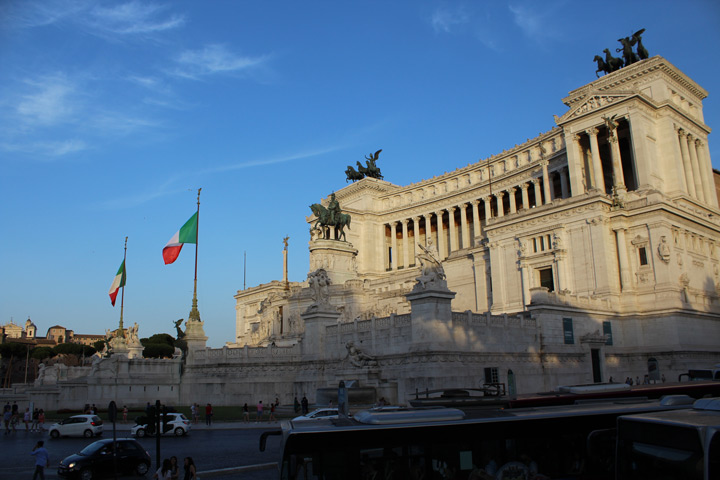
Il Vittoriano: All the class of an Italian-themed casino, but actually in Rome!

Enjoying the sunset from the top of the Capitoline Hill.
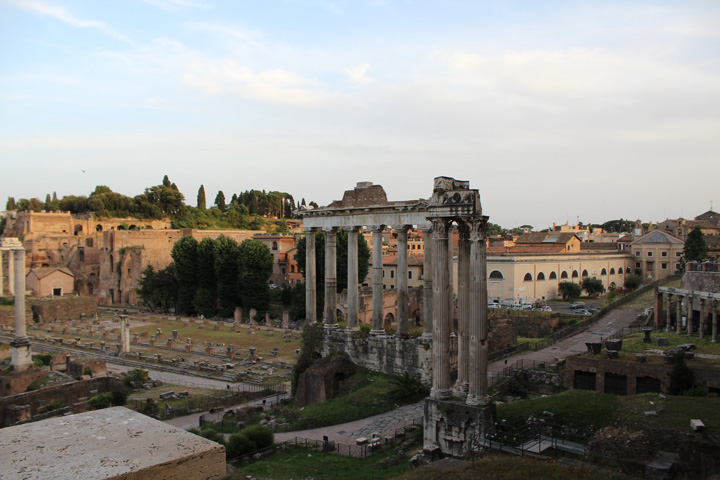
Our first view of the Forum. It looks kind of ruined.

Excited to see the shooting locations from "History of the World Part I"
Even better, Allyson set us up in a hotel at the center of the Roman Empire. The Otium -- Otivm for the true Romans -- is on the Via D'Aracoeli, just a block or so from the northern end of the Roman Forum. It's a small hotel, with an elevator that barely fits two people standing side by side. But the room was pleasant, the location was amazing, and the roof deck was extraordinary. It was right around dinner time when we arrived, so we had the concierge recommend a restaurant. He steered us to Trattoria Angelica, right around the corner. It's probably nothing special by Roman standards, but we were sitting at an outside table in a cobblestone alley while people served us wine and pasta. It worked.
When traveling internationally, you have to force your body into new time zones as quickly as possible. So despite our carb- and wine-heavy dinner, we marched like a Roman Legion. We climbed the Capitoline Hill, with its elegant papal palaces and a staircase designed by Michelangelo. We circled behind Il Vittoriano, the ill-advised monument to the "modern" Italian state. It's a neo-classical monument, started in the late 19th century and finished by Mussolini. Guidebooks (and guides) will tell you that the Italians hate it, because it seems like a gaudy appropriation of the past: It's built to look like an important Roman structure, but next to all the actual Roman structures it looks like the front of a Las Vegas casino. They call it "The Wedding Cake," or "Mussolini's Typewriter," or "That Ugly Pile of S*** Over There." Ironically, although you can walk right up to most actual ruins, a gate keeps most visitors a healthy distance from Il Vittoriano. That said, it is totally awesome when you need a landmark to find center city, because it sticks out like a sore thumb.
And that's why it was the perfect meeting place for the first tour of our vacation. Some people think walking tours are lame or inauthentic. But accomplished international travelers such as Allyson and me know that walking tours are super cool activities that really fun people do all the time. If you think about it, isn't life just a walking tour where Jesus is your guide? Yeah.

Show up, take a walking tour. It's the law.
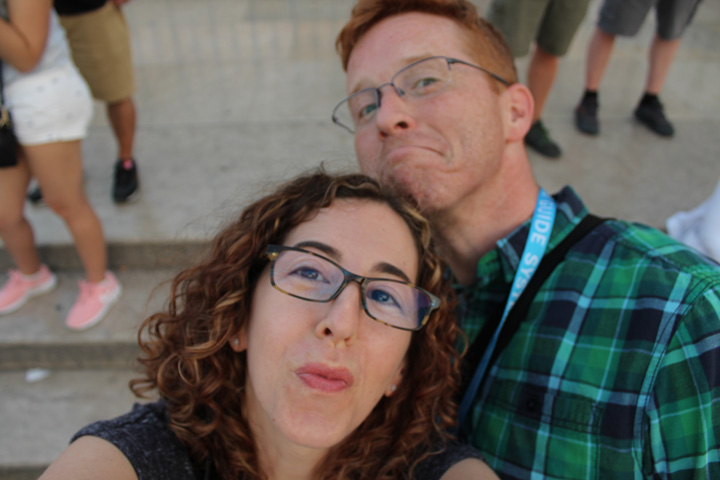
The waiting is the hardest part. Getting ready for the tour.
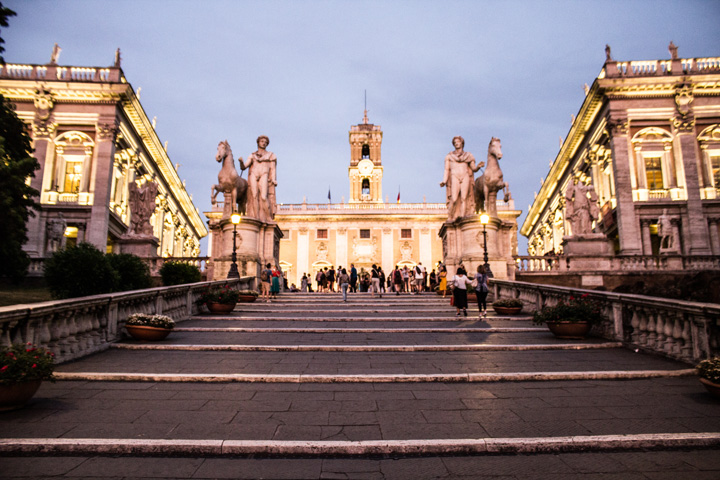
Michelangelo's famous staircase up the Capitoline Hill.

Yeah, it's a historic stadium, but do they have gourmet hot dogs?
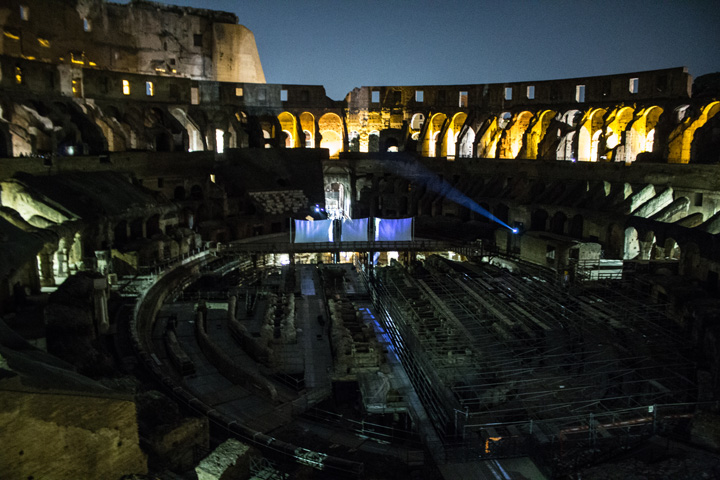
The only real disappointment of the trip. Turn the lights on, geniuses.
Anyhow, we were locked in to see the Colosseum at night. Western civilization is largely based on Roman law, and one of the most ironclad laws of Rome is that all visitors must see the Colosseum. If you tell people you went to Rome, they'll ask, "Did you see the Colosseum?" If you don't go, they'll ask, "Why didn't you see the Colosseum, the site of an epic battle between Chuck Norris and Bruce Lee?" Even people who hate history love the Colosseum, because it's the world's most historic sporting venue. And who doesn't like sports? Losers, that's who. Plus, there are theoretically big advantages to seeing the Colosseum at night. Because it is one of the world's biggest tourist attractions, visiting during the day has the potential to be a nightmare. Inexplicably, many people seem to travel to Rome without booking anything in advance, and as a result they spend 60 percent of their time getting sized up by pickpockets while standing in entry lines. All night tours are reserved in advance, so there are no lines, and with the sun out of the picture it is theoretically less smelly. It just makes sense.
So at 8:30, we made our way to the front of Il Vittoriano to meet up with our guide from "The Roman Guy" tour company. In this case, the Roman Guy was a British Gal named Amanda. She was an expat who had been living in Rome for several years. She had quit a career in finance to put her aspirational art degree to work. And she was thoroughly engaging! At the start, she pointed out "Mussolini's balcony" in the Il Vittoriano square, attached to the office where he made many of his soul-crushing decisions. She shared the rumor that Mussolini had the Via del Fori Imperiali -- the wide street from his office to the Colosseum -- constructed just so he'd have a view of the historic arena. (And why not? There have to be SOME benefits of being a fascist dictator.)
As we walked up the Capitoline Hill, she explained that a patron hired Michelangelo to design its plaza and steps after being embarrassed by the muddy conditions during the visit of some dignitary. That's Rome for you: Got a mud problem? Why not hire the greatest artist on the planet?
Outside the Capitoline museums, we paused at a replica of the famous statue of Romulus and Remus suckling on a wolf's teat. Amanda explained that the city's founders might have been raised by wolves, at least in spirit -- a "lupanarium" is a whorehouse, and abandoned twins might have found safe harbor in the home of a lonely sex worker. Overlooking the Forum, Amanda pointed out the Temple of Saturn as a center of finance, where money reserves were stored. She described Trajan's Markets as the first shopping mall. She laughed at how Rome's street performers all sing American and British songs, rather than Italian. And she lamented that the metro line being dug underneath the Colosseum was cutting through centuries of history.
When we reached the Colosseum grounds, Amanda evaluated the mythology. Most games were not deadly; it was an entertainment venue, and killing gladiators would be an awful business model. It was, in fact, the forerunner of the modern stadium: rich people seated below and poor people up top, in a circular building with an oval arena floor. The nickname "Colosseum" (it's really the Flavian Amphitheater) came from the monumental statue that had been out front -- "the colossus of Nero." (The area where the building stands had been part of Nero's enormous palace grounds. Supposedly the emperor Hadrian had the statue installed on the site, and the foundations of the statue's pedestal are still there.)
Unfortunately, that was the end of Amanda. At some point after we booked our tour, the Italian cultural trust that operates the Colosseum decided to get wacky. They created a "Moon Over the Colosseum" tour, which dictated the agenda for nighttime visitors. Regular guides would be replaced by Colosseum-sanctioned guides (in our case an Italian lady who spoke broken English), and the visit would be punctuated by bizarre video presentations geared toward an international audience. Basically, animated silhouettes would tell you about the experience of fighting or working in the building, in language that could easily be translated for many different cultures. The culmination of the tour would be the "Gladiator's Dream," an awful, allegorical 12-minute presentation shown to audiences waiting on the very floor of the arena.
The thing is, if you want to show movies, you can't turn the lights on. We took a "Colosseum at night" tour where the operators refused to illuminate one of the most iconic structures in the world, in fear that it would wash out the screen. People on the tour (including me) were asking when the lights would be turned on. We had seen pictures of the Colosseum lit up with flood lights at night, looking very ruined and very ready for the next Norris-Lee throwdown. The selling point on this tour was seeing one of the most famous buildings in the world without the daytime crowds -- but they didn't let you SEE it. Every other tour group we passed that night had the same expression: What the hell is going on here? When you're standing in the middle of the most famous arena in the world, why would you want to watch a video? It made no sense, and everyone on the tour seemed angry. Weeks later, I wrote the The Roman Guy and got a partial refund. It was less glorious than gladiatorial combat but I guess it counted as a partial victory.
We licked our wounds, and some gelato, on the way back to the hotel. And while we were glum at the time, that turned out to be the worst experience on our entire vacation. But if any tour operators are reading this, here's some friendly advice: No one flies thousands of miles to visit one of the most famous places in the world, just to watch a video. All roads should not lead to a mediocre attempt at spending grant money.
